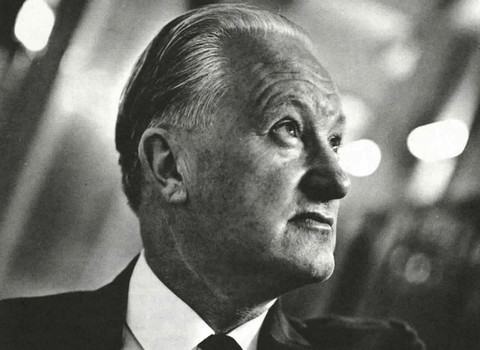Sourced from the Sydney Morning Herald.
A recent article in the Herald on the new ABC logo contained an interview with the designer of the original logo, Bill Kennard, senior graphic designer at the ABC from 1956 to 1974. The article prompted Bill’s former colleague, Storry Walton, to write to him recalling “the extraordinary quality of graphic art you brought to the ABC and the exceptional stable of artists you recruited”.
This, the latest in a series of accolades that accompanied every stage of Bill’s career, eloquently summarises his legacy. He was born in England in 1915. In the course of a remarkable working life, which began as a 14-year-old apprentice signwriter in the town of Ruislip, he became an award-winning graphic designer, credited with creating one of the most recognisable and enduring corporate identities in Australian history.
At 19, with his apprenticeship behind him, Bill accepted a job as a set painter and decorator at Denham Film Studios. It was a burgeoning time for British film-making, and Bill worked on many of the great films of the day, including Great Expectations, In Which We Serve, The 39 Steps and the Olivier classics Hamlet and Henry V. In later years he recalled watching many of the stars at work, among them Marlene Dietrich, John Mills, Charles Laughton, Noel Coward and James Mason.
In 1939 Bill enlisted in the RAF as a flight mechanic and began the first of many postings across the UK. At war’s end he returned to the film industry, working at Denham and Elstree Studios for a further four years before moving to television as a graphic designer with the BBC. There he inherited a tradition of excellence which was to be the benchmark for the remainder of his career.
Recruited by Talbot Duckmanton, who visited the BBC looking for talent for the fledgling Australian national broadcaster, Bill arrived in Australia in 1956 accompanied by his wife and two daughters. He began work at the ABC as senior graphic designer, though at the time he was the only employee of his department. Working out of an office above a shop in Crows Nest, his first task was to scour the country for suitably skilled staff.
Seeking artists, rather than technicians, and then only those with the skills and vision capable of achieving real quality, Bill managed to assemble an extraordinary pool of talent. Of the 100 or more artists whose careers he nurtured during 17 years as head of the ABC graphics department, many, including John Coburn, Tim Storrier and photographer Wes Stacey, went on to make their mark in the wider sphere of Australian art.
During this heady time, Bill and his department worked under pressure to perform small miracles for the program makers of the day. He recalled with amusement how he had once improvised a roller caption machine out of two rolling pins and a gramophone motor. This “emergency” solution was pressed into service for an entire year before being replaced with the real thing.
As the years passed, Bill continued to steer his department towards excellence, fostering teamwork and matching talent to the tasks at hand. He encouraged team members to enter their work into industry exhibitions, winning, in 1963, a special award from the ACIAA (Australian Commercial and Industrial Artists Association) for the outstanding excellence of his team’s entry.
The ABC had been unsuccessfully searching for a definitive corporate logo for two years when it accepted Bill’s design in 1965. His Lissajous figure, derived from an oscilloscope waveform for measuring radio and television frequencies, was a masterpiece of style and simplicity. “Crisp, functional and of its age,” as it was heralded at the time, it remains instantly recognisable and fondly regarded by Australians everywhere. The ABC, who paid £25 for Bill’s efforts, must surely regard it as one of their better investments.
Although ill health forced his departure from the ABC in 1974, in retirement Bill continued to live an active and happy life, indulging his passions for music, painting, model-making, golf and travel. His death last month brought many tributes from industry colleagues acknowledging his role in promoting excellence in graphic design during the formative days of Australian television. This was surely his greatest achievement.
For most of us, however, Bill lives on in that funny little squiggle we know so well. As tributes go, I’m sure he wouldn’t have minded that at all.
Isabel Hogan and Shirley Kennard, 2001.
